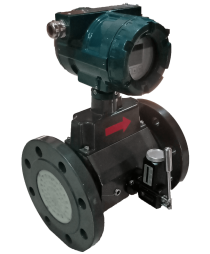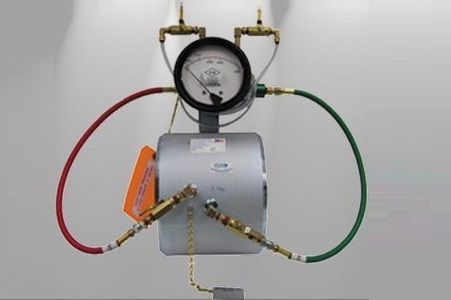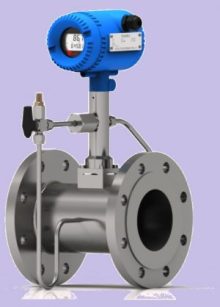Flow Meter is a unit of measurement on the movement of fluids or fluids that are familiar to workers in the field of construction, mining, etc. In everyday life we often encounter such measurement tools such as regulators on gases, water pumps, and PGN gas meters. Before we discuss about “9 Flow Meter Recommendations Based on Their Type” we must know in advance what is a flow meter?
Flow meter itself is a measuring instrument used to determine a large amount of flow from all materials such as air, fluid or powder. The flow measured through this instrument is the rate of flow and volume that flows over a period of time. then what types of flow meters are used in Indonesia and Recommendations flow meters based on their type, we just discuss below:
1. Ultrasonic Flow Meter
Who doesn’t know this type of flow meter? Yes, the first flow meter recommendation is ultrasonic flow meter is a flow meter whose way of working to measure or calculate the flow speed of a fluid by using ultra sound for flow rate accumulation. With the known flow speed, it can be calculated flow rate by knowing the area of support of a flow path.

Ultrasonic Flow Meter is widely known as a flow meter whose installation system uses a non-contact system where the sensor or transducer does not contact directly with the fluid. Because the way the installation is non contact or clamp on, ultrasonic flow meters are known as portable flow meters.
Likewise for ultrasonic insertion flowmeter installation system the way the installer is to perforate the pipe which is then installed fittings and ultrasonic sensors or transducers are inserted in fittings and pipes that have been in the hole. From the sensor by using cable is forwarded into the ultrasonic transmitter to calculate the velocity and flow rate of fluid in the pipe.
Types of Ultrasonic Flow Meter Installations
- Portable Ultrasonic flow meter
- Clamp on fix ultrasonic flow meter
- In Line Ultrasonic Flow Meter
- Insertion Ultrasonic Flow Meter
- Open Channel Ultrasonic Flow Meter
From the type of ultrasonic flow meter based on the way of installation that is most preferred is the type of clamp on installation because it is very suitable in application to very large pipes or in pipes that they do not want to be disturbed the production process. We recommend this type of Ultrasonic Flow Meter that is portable, why? See below:
Portable flow meters began to be famous when the flow meter type ultrasonic where the way of use and installation is quite easy and fast and can be below where.
Portable flowmeter uses a type of clamp on flow meter where the sensor or often referred to as ultrasonic transducer is enough in the clamp on the outer surface of the pipe, because the installation process without cutting the pipe or perforating the pipe then the installation cost of the flow meter clamp on is very cheap and fast.
Kegunaan Portable Ultrasonic Flow Meter
- To check the performance of the pump
- Analyze processes related to fluid flow rates
- Checking hvac system because it can also be connected with thermo sensor
- Calculate heat energy
- Check the engine cooling system from the water flow for cooling tower
- Knowing the size of the fluid water by adjusting the size of the valve
- Check the presence or absence of flow in a pipe
- Serves as a flow meter with a limited time in accordance with the energy capacity stored in the battery charger.
2. Electromagnetic Flow Meter
Electromagnetic flow meter or Magnetic Flow Meter and often called magmeter is a type of flow meter that does not have moving parts . Magnetic flow meter is ideal if used for measurement of fluid flow that is not homogeneous, dirty liquids, liquids containing sludge or for waste fluids or intake water, raw material water, water from reservoirs or rivers that contain a lot of dirt or garbage (plastic, grass or others), so it is quite suitable for use for waste flow meters.

Magmeter or electromagnetic flow meter can only be used in water applications that have certain conductivity, in accordance with the rules required by each electromagnetic flowmeter manufacture.
In general, magnetic flowmeters do not work in hydrocarbon fluids and distilled water (demin water). However, it is ideal for measuring the flow of liquids such as slurry and corrosive materials such as chemical processes or beverages and viscous water liquids such as soy sauce, sauce, syrup and others.
This electromagnetic flowmeter is very suitable for use in flow systems that require a very low pressure drop. The working principle of this type of electromagnetic flow meter is based on the law of electromagnetic induction (Faraday’s Law), which is that when an electrically conductive fluid passes through an elecromagnetic sensor pipe, it will work as a moving conductor cutting the magnetic field generated by the magnetic coil of the sensor/ transducer, resulting in an induction electric voltage.
Magnetic Flow Meter Components
- Magnetic Flow
Sensor Magnetic flow sensor there is a compound in the form of flow tube, electrode, coil cover and connection both in the form of flange and thread. - Magnetic Flow
Sensor Flow Transmitter that has the function of translating signals from elctrode into speed calculations and others that can be displayed in the form of numbers to the display and provide other ouput. Magnetic flow trasnmitter is usually only divided in the form of fused with sensors or separate, the term on the ground is compact / integral or remote / split.
3. Turbine Flow Meter
Turbine Flow Meter (axial turbine) was created by Reinhard Woltman and is an accurate and reliable flow meter for liquids and gases. This flow meter uses the mechanical energy of the flowing fluid to rotate a “pinwheel” (rotor) translating the mechanical action of the turbine’s rotation in the flow of the fluid around its shaft into a readable flow level (gpm, lpm, etc.) The turbine tends to follow the flow journey around it.

Turbine Flow Meter function
Turbine flow meters can be used to measure the flow speed of liquids, gases and vapors in pipes, such as hydrocarbons, chemicals, water, cryogenic fluids, air, and industrial gases. It should be considered in determining the turbine flow meter should be careful on dirty liquids (containing garbage, sand and other solids).
Because the dirt that passes through it will be able to inhibit accuracy and will even fail because the rotor can not rotate due to snagged dirt. Likewise for liquids that are non-lubricating, because the flowmeter can become dysfunctional or its accuracy deviates too far because there are turbine flowmeters have grease fittings for use in liquids that do not have lubrication properties.
Turbine Flow Meter Application
The application of turbine flow meters is less accurate at low flow speed levels because it can slow the rotor rotation. Meanwhile, for the installation of turbine flow meters there are inline using thread flange connections and there are also those who use the insert method can be known as insertion turbine flow meter.
4. Positive Displacement Flow Meter
The next flow meter recommendation is a Positive Displacement Flow Meter or often called a PD Flow Meter is a type of flow meter that measures the volume or flow rate of fluid movement by dividing the fixed media room with a measurable volume.

Advantages of Positive Displacement Flow Meter
Applied to household natural gas and water metering. The diaphragm argometer, which is mostly used in tanga houses, is an example of a single PD flow meter. This type of meter in its application attracts and holds and transfers fluid in order to take up space in the meter so that it functions from this tool to read the flow rate and total fluid flowing to function as it should.
Disadvantages of Positive Displacement Flow Meter
PD flowmeters measure the rate of flow of volume or flow of moving liquids or gases by dividing the medium by staying at a measurable volume. The device consists of a space that blocks the flow of media and a rotating or reciprocating mechanism that allows part of a fixed amount of volume. The amount of fluid that passes through the room determines the volume of the fluid. The level of revolution or spin determines the rate of flow.
5. Differential Pressure Flow Meter
Differential pressure or head flow measurement is the most popular flow measurement method today for measuring fluid flow in the process industry. This flowmeter is applied to cryogenic, Clean Gas, Dirty Gas, Clean Liquid, Dirty Liquid, Viscous Liquid, Saturated Steam, Superheated Steam and is not recommended for Corrosive Liquid and Abrasive Slurry.

Advantages of
Differential Pressure Flow Meter
- Initial procurement costs: low ~ medium
- It can be used in a wide range (almost any fluid phase and flow condition).
- The structure is sturdy and simple.
Disadvantages of Differential Pressure Flow Meter
- Pressure drop: medium ~ high
6. Rotameter
The variable area flow meter , also commonly known as a rotameter,consists of an oblong tube of glass, with an inside buoy being pushed upwards by the flow of fluid and pulled down by gravity. As the flow level increases, the increased pressure pushes the buoy up until it stays in place inside a tube wide enough to balance the pressure. Buoys are made in various shapes, the shape of commonly used circles (rotameters).

Some buoys are designed to be seen rotating in the flow of liquid objects to help the wearer determine whether the buoy is stuck or not. Rotameter is available in wide application of liquid levels, but is most commonly used for water and wind. This powerful tool measures up to 1% accuracy.
Advantages of Rotameter
- The cost of a rotameter is low.
- Provide linear scale.
- It has good accuracy for low and medium flow rates.
- The stress loss is almost constant and small.
- Uses for corrosive liquids.
Lack of Rotameter
- When an opaque liquid is used, the buoy may not be visible.
- Not so good in throbbing service.
- This type of glass tube was damaged.
- It can only be installed in a vertical position.
7. Thermal Mass Flow Meter
Thermal Mass Flow Meter uses the principle of convective heat transfer in a fluid to measure the rate of flow flowing in a pipe or channel. Generally in thermal flowmeters there are two temperature sensors. One of the sensors is heated at a certain temperature by a circuit and serves as a flow sensor. While the second temperature sensor acts as a reference sensor, and measures after recording the temperature of the gas.

Thermal Mass Flow Meter Application
Thermal mass flow meters are widely used in various industries with a variety of different applications. The applications are grouped into energy conservation, environmental functions, industrial use and measurement with specific gases such as in nitrogen blanketing processes.
Thermal mass flow meter has the function to measure the speed of gas flow, gas temperature, gas flow rate and total mass of gas passing through the flow meter sensor. This function is displayed by a thermal mass flow transmitter that produces digital displays, data and other aoutput that can be used for control or others.
Thermal mass flow meters can be used by almost any type of gas such as air, oxygen, nitrogen, helium, argon, CNG, natural gas, CO2, and other gases.
Advantages of Thermal Mass Flow Meter
The advantage of a thermal flow gauge is that it has no moving parts. It reduces maintenance and allows use in demanding application areas, including saturated gases. They also do not require temperature or pressure correction and provide excellent overall accuracy and repetition over various flow rates. This meter force calculates mass flow rather than volume and is one of several categories of meters that can measure flow in large pipes.
Lack of Thermal Mass Flow Meter
The flow meter distributor/vendor should provide proper calibration information for other gas mixtures. However the accuracy of a thermal flowmeter depends on the same actual gas mixture as the gas mixture used for calibration purposes. In other words, the accuracy of the thermal flowmeter calibrated for a given gas mixture would degrade if the actual flowing gas had a different composition.
8. Coriolis Mass Flow Meter
The accuracy of the Coriolis flow meter is a flow meter that has a high enough accuracy, but which needs to be underlined, in the specification has an accuracy rate in calibration that varies from 0.1%, 0.2%, and 0.5% so as to distinguish from the selling price, in Rheonik has an accuracy standard of 0.2% (Maximum). However, the expensive price will be replaced by the high accuracy that can be obtained by this flow meter.

How The Coriolis Mass Flow Meter Works
The coriolis meter has positive and negative coriolis acceleration into the measurement process, as illustrated in the image above where the fluid is flowed through two curved tubes. The excitation force of the oscillation is aimed at the tube through miniature velocity transducers or electric coils thus causing vibrations measured by magnetic sensors.
Advantages of Coriolis Mass Flow Meter
- Better accuracy than most other flow meter technologies.
- Can be used in a variety of liquid conditions (the list of liquids can be seen below)
- Able to measure the flow of hot liquids (example: Liquid sulfur) and cold (example: Liquid nitrogen)
- Decrease in low pressure
- Suitable for two-way flow
9. Vortex Flow Meter
The last flow meter recommendation is vortex flow meter is one of the flow meters that can measure 3 types of fluids such as gas, liquid and steam. Thanks to this technology it provides cost-effective, reliable, and low maintenance solutions for many flow measurement applications. Vortex flowmeters have no moving parts, therefore no routine maintenance or cleaning is required. Vortex flow gauges can also measure wet and/or dirty gases.
Vortex flow reading technology relies on measuring the number of pulse vortexes produced by a bluff body immersed in a stream stream. Bluff bodies work inside vortex flow meters. As the flow passes through this snapping body, vortices are generated on both sides of the snapping body. The rate of flow can be determined by measuring the amount of vorticity.

Working Principles of Vortex Flow Meter
Measurement of vortex flow transducer flow in accordance with the principle of Karman Vortices. When a bluff body is placed vertically inside the pipe, when fluid flows around the bluff body, regular vorticity columns will be generated alternately on each side of the bluff body, these vortexes are known as “Karman Vortices”. The resistance part that releases vortices is named “bluff body”. The frequency of vorticity release is related to the speed of the liquid.
Advantages of Vortex Flow Meter
- Can be used to measure all the flow of objects in the form of liquid objects, air, steam, and gases
- Has a larger cross-sectional diameter of flow
- Can produce output points in analog and digital form
- It is more durable because no part of the flow meter moves or rotates
Lack of Vortex Flow Meter
- The standard accuracy of vortex flow meters is quite low, which is in the range of 2%.
- Another drawback is that vortex type flow meters cannot be used to measure solid objects.
Thus the Article on “9 Flow Meter Recommendations Based on Its Type” hopefully can provide ‘suggestions’ to its readers to be more stable in the selection of flow meters based on their type.
